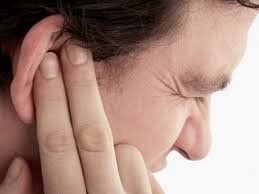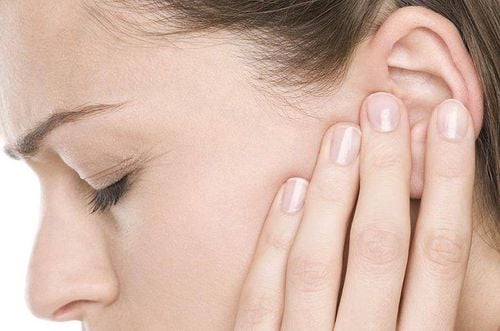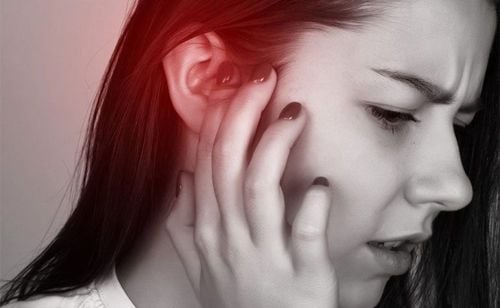This is an automatically translated article.
The article was professionally consulted by Specialist Doctor Ear, Nose Throat Doctor - Department of Medical Examination and Internal Medicine - Vinmec Ha Long International Hospital
Chronic otitis media can be caused by many causes, perforation of the eardrum is a consequence of otitis media. When the eardrum is punctured, it can affect the patient's hearing, even lose the ability to hear or affect the inner ear very dangerously.
1. What is chronic otitis media?
The structure of the ear consists of three parts: the outer ear, the middle ear, and the inner ear. In which the outer ear and the middle ear are separated by the eardrum; The middle ear is a cavity containing a lot of air, the ear bone system and has the Eustachian tube down to the oropharynx. The inner ear is shaped like a snail shell and contains the vestibular system of the cochlea and the VIII nerve.
The middle ear is susceptible to infection because when the oropharynx is infected, the Eustachian tube is blocked, causing fluid to stagnate in the middle ear, causing diseases from the oropharynx to the middle ear. Chronic otitis media is an infection of the middle ear that lasts for more than 12 weeks, with little or no response to medical treatments.
There are two types of chronic otitis media including:
Chronic otitis media without cholesteatoma: This type usually has a mild course, with a good prognosis. There are few serious complications. Chronic otitis media with cholesteatoma: This case has a worse prognosis because of bone destruction, invasion of nearby organs, causing encephalitis, brain abscess, 7th nerve palsy, and venous sinusitis. ...
2. Causes of chronic otitis media with perforated atrial fibrillation
Causes of chronic otitis media with atrial perforation include:
Due to acute otitis media develop into: The most common cause, occurring more in children. Commonly seen after upper respiratory tract infections including VA, tonsillitis, pharyngitis, rhinosinusitis ... If untreated or incompletely treated, it leads to fluid stasis in the middle ear, which causes tension and perforation. eardrum to drain fluid out through the external ear canal. However, if treated correctly at this stage, even though the eardrum has perforated, it is likely that the eardrum will heal, if not treated correctly or the perforation of the eardrum is too large and cannot be healed, the disease will turn to otitis media. chronic atrial perforation. Necrotizing otitis media: Similar to the case of acute otitis media, but the bacteria are too virulent or the body's immune status is weakened, so the disease progresses quickly, the eardrum is wide, often no ability to heal spontaneously and lead to chronic otitis media with atrial perforation. Injury: The main cause is usually an earwax removal tool, which is pushed deep inside, causing a puncture of the eardrum. After an injury, if the perforation is small, the eardrum may heal on its own; If the perforation is large, it will be difficult to heal on its own, leading to chronic otitis media. Perforation of the eardrum due to otitis media will impair hearing, in more severe cases, permanent hearing loss.
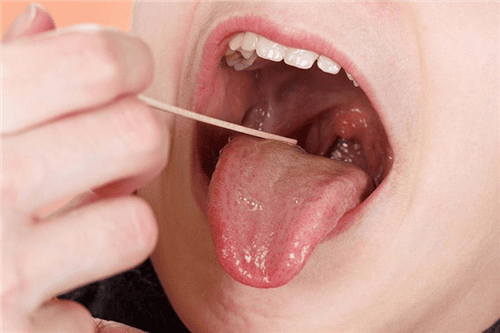
3. Symptoms of chronic otitis media with atrial perforation
When there is chronic otitis media with perforated atrial fibrillation, the patient may have symptoms such as:
Hearing loss: Hearing loss in this disease has increasing characteristics. The condition varies depending on many factors such as wide perforation, long duration of the disease, repeated purulent discharge, damage to the ear bone chain that transmits sound in the middle ear... Hearing loss is often difficult to detect, because the patient normal hearing on the other side, detected by audiometry. Ear discharge: A condition in which fluid flows from the middle ear to the outer ear canal. This fluid has the following characteristics: -Color: May be clear, milky, yellow or green, sometimes mixed with a little blood...
-May be continuous or intermittent ear infection
-Odor: Possible odorless or foul-smelling.
-Can be as thin as water or mucus, sometimes like a thick glue that is hard to come out.
Tinnitus, dizziness: Because chronic otitis media affects the nervous system or the body's balance system, one or both symptoms of dizziness and tinnitus may appear. At this stage, the cure rate is relatively low with either aggressive treatment or surgical intervention. Some signs caused by complications: Damage to the inner ear, causing loss of balance; meningitis causes symptoms such as vomiting, stiff neck, headache...
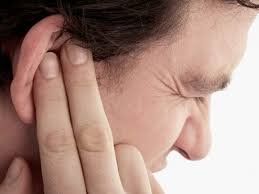
4. Complications of chronic otitis media with perforation of the tympanic membrane
Chronic otitis media can lead to a number of complications such as:
Bacterial infection damages the skeletal system in the tympanic cavity, destroys the labyrinth. May cause facial nerve paralysis. Cranial and systemic complications such as: lateral venous sinusitis, bacteremia, meningitis, cerebellar abscess, epidural abscess... These complications are very dangerous, can lead to death.
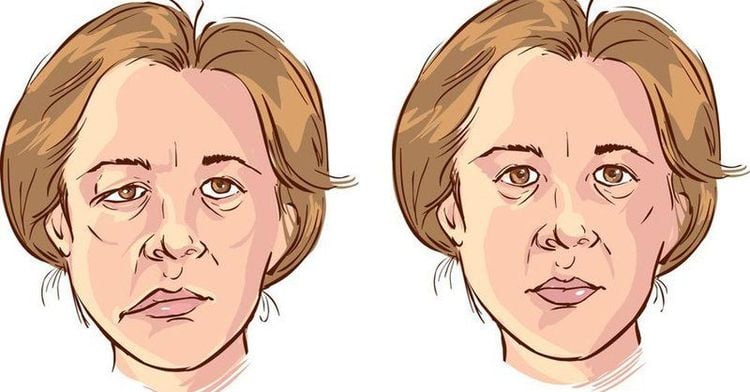
5. Treatment of chronic otitis media with atrial perforation
5.1 Medical treatment
Medical treatment applied in case of otitis media with purulent discharge without mastoiditis, no cholesteatoma, no complications.
Conservative treatment options include:
Antibiotic treatment Need to drain the ear canal to keep the ear canal clean, remove polyps if present Ear hygiene Use ear drops Ear hygiene is considered an important step important, can limit infection, make the treatment process more effective and faster. But how to clean properly is very important. Steps to clean the ears include:
Prepare a soft towel, clean warm water and physiological saline, ear wash as prescribed by the doctor if available. Implementation: Mix physiological saline with warm water, dip a clean towel and wring it dry, then wipe the outer ear area. Use physiological saline drops into the ear or use a specialized ear cleaner. How to drop the ear: Tilt your head so that the ear has the perforated eardrum above, then drop physiological saline into the ear canal. Hold the head for 1 to 3 minutes, then tilt it back to let the excess water inside drain out. Finally, use a clean cloth to wipe it again. Should perform ear cleaning about 2-3 times a day to keep the ear canal clean and avoid infection.
5.2 Surgical treatment
Indications for surgery for chronic otitis media when:
Chronic otitis media is accompanied by chronic mastoiditis. There is cholesteatoma Intracranial complications... Inflammation recurs many times without effective medical treatment. Widely indicated in children, early surgery should be considered for otitis media with effusion in children to avoid complications later and preserve hearing. The surgical methods that are being applied today are:
Tympanic membrane surgery Orthopedic ossicles Hollow out the mastoid: When mastoiditis, or cholesteatoma in the mastoid.
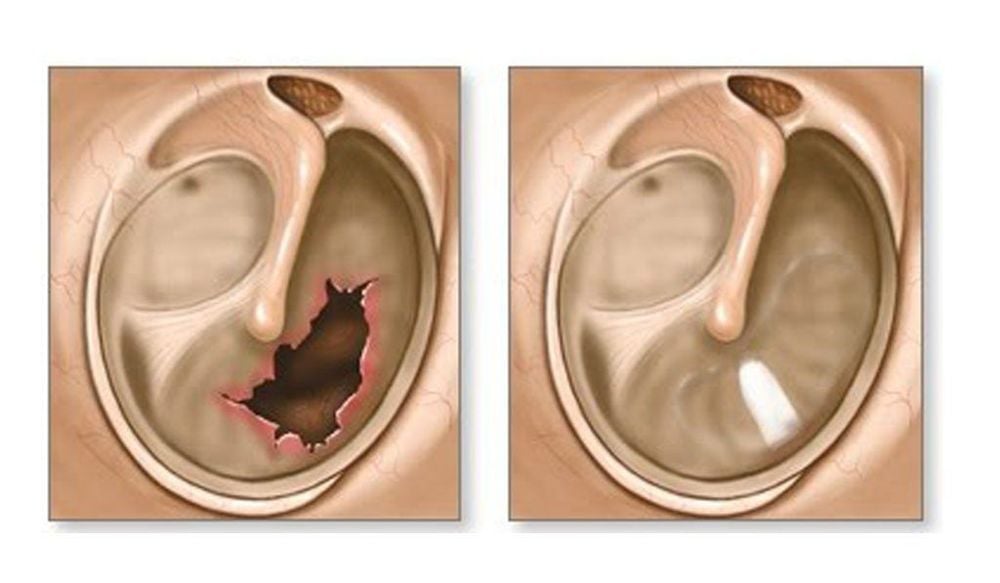
5.3 Some notes when suffering from chronic otitis media with perforated atrial fibrillation
Absolutely do not let unclean water enter the ear. Care should be taken when bathing so that water does not enter the ears. Do not go swimming while being treated for otitis media with atrial perforation. For children, do not breastfeed because it is easy to cause milk to flow into the ear and make the infection worse. Do not expose to loud sounds and do not use hard objects to remove earwax. Pay attention to clean the nose and throat with physiological saline. Have a diet that provides all the necessary nutrients.
6. How to prevent otitis media
To prevent otitis media in general, it is necessary to prevent the risk of causing upper respiratory tract infections such as nasopharyngitis, VA, sinusitis, tonsillitis... by full vaccination, rinsing mouth, gargle with physiological saline, eat nutritious food... Avoid cigarette smoke because this is a high risk factor for upper respiratory tract infections and thereby cause otitis media. When you have an upper respiratory infection, it needs to be treated early and properly. When there are symptoms of ear problems, they should be examined and monitored at medical facilities, not self-treatment. Chronic otitis media with atrial perforation can cause many complications, when there is a suspicion of chronic otitis media, you should go to medical facilities for early treatment, to avoid leaving sequelae later.
Vinmec International General Hospital with a system of modern facilities, medical equipment and a team of experts and doctors with many years of experience in medical examination and treatment, patients can rest assured to visit. examination and treatment at the Hospital.
Please dial HOTLINE for more information or register for an appointment HERE. Download MyVinmec app to make appointments faster and to manage your bookings easily.




